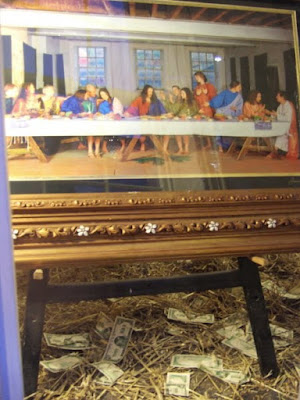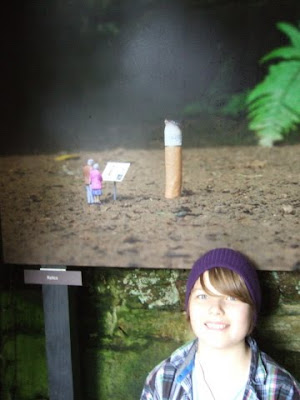
Exhibiting in the Liverpool Biennial 2010 was a really exciting event for me this year.
Blink UnBlink was the name that Olwen Holland and I gave to our two person show at The International Gallery (Slater Street). Blink UnBlink was part of S.Q.U.A.T. Liverpool and was curated by Gregory Scott Gurner and Asher Remy Toledo.
When Olwen and I first saw the gallery we both fell in love with the character of the building. We both loved its 'worn by time' look. You can’t rush that sort of scruffy floor, nor can you speed-grow a plant through the ceiling!
And like the previous exhibiting artists we decided to make a feature of our little green tendril.
 View looking up under Tall Legs
View looking up under Tall Legs Our lovely floor
Our lovely floor Using normal white plinths just didn't fit with this space. We found the perfect rusted metal table to present 'Hyacinth' on. Gregory was pleased that we managed to make use of items within the building. This is totally in keeping with the ethos of S.Q.U.A.T. and The Art Organisation.
Using normal white plinths just didn't fit with this space. We found the perfect rusted metal table to present 'Hyacinth' on. Gregory was pleased that we managed to make use of items within the building. This is totally in keeping with the ethos of S.Q.U.A.T. and The Art Organisation. 'Precious'. One of the new beings made for this show. I really enjoyed making 'Precious', especially as rather than feeling precious I was feeling playful while making her.
'Precious'. One of the new beings made for this show. I really enjoyed making 'Precious', especially as rather than feeling precious I was feeling playful while making her. 
I recently read Richard Branson’s Blog.
He has answered 60 questions in celebration of his 60th birthday.
One question was, What three things does he feel have been most important to his success? His answer was, “People...people...and people....”
Yes Mr Branson and I have something in common... a love and enthusiasm for people.
 'Fin' (AKA Giovanni) presented on two vintage instrument boxes. I have Richard Bett (very talented silversmith and metal sculptor) to thank for these boxes.
'Fin' (AKA Giovanni) presented on two vintage instrument boxes. I have Richard Bett (very talented silversmith and metal sculptor) to thank for these boxes.
The Liverpool Biennial attracts visitors from all over the world and while our show was on Olwen and I met all sorts of people. We had curators from Poland, Canada, Ireland and various UK galleries visiting. We had students not only from UK BA and MA courses but also students from Ireland, Holland and Greece (that we know of).
Some of my most enthusiastic visitors were Daniel Ernst, Jonathan van Sloten and Catinka Kersten who are studying at Hanze University Groningen
I was really excited when Daniel pulled out his vintage 3D camera.

and here is the image that he took. Dig out your 3D glasses to get the full impact. Daniel's blog is an exciting world of fantasy and reveals a very healthily imagination!


David Kousemaker and Tim Olden designers from Blendid came to our opening event.
David’s comment, “I like when art tickles you a bit”, really stuck in my mind.
I love Blendid's interactive lighting works and so you never know, one day we could possibly work on a project together.
It’s about people and connections; that’s what makes my world go around.
Being in Liverpool during the Biennial there was a wonderful feeling of camaraderie.
It was lovely that some people decided to pop in to visit us several times over the weeks. Mark the ancient languages expert, Terry Wafer who has since been sharing his own photographs with me, Simon who told me tales of working at the Beatles Experience, Stuart from Feeling Listless. (He also wrote a piece about Blink UnBlink) to name just a few.
The International Gallery is in a great location just around the corner from FACT and also only spitting distance from the DO HO SUH public art piece ( Bridging Home).
Many visitors were passing on their way up to the Anglican cathedral. I loved the video piece (Grand Organ) by Danica Dakic. Definitely my favourite of the Biennial and I was so glad that I had heard her speak about her work when I went to the Touched Conference in September.
While in the gallery I read lots of online reviews of the other shows and so every day before The International Gallery opened I visited other shows; both ones in the main Biennial and also others which were in the Independents Programme.
Art Liverpool is a fantastic website and there was lots of publicity for our show.
It was great to be able to get feedback directly from visitors.
And even now, months later, I am hearing from people who visited Blink UnBlink. As with so much in the art world there is often a delay between action and result. Often the things that we do seem to lie dormant for even years before bearing fruit!
There were also visitors that I didn’t actually meet in the flesh but who I made contact with purely as a result of the show. Jonathan Baldock showed at the Royal Standard. I am definitely intrigued by and interested in his work.
While in lIverpool I visited the Ceri Hand Gallery. I did this especially as she now represents the Juneau Projects and I’m always keen to see what they are up to. I loved the gallery but didn’t meet Ceri until a few weeks later when she spoke at one of the Art of Ideas talks.
So what lessons have I learnt from this most recent phase?
Yes people are still very much part of my practice. They energise me, make me feel connected and inspire me.
The work that I make is about relationships, personalities and how we relate to each other.
Matt Price once described my work as revealing a childlike enthusiasm.
I am also often described as having a lot of energy and optimism.

Celebrating at the end of the show. Always best done with family and friends.
In the dark winter months I often feel disgruntled. During the winter I just want to hibernate. I want to stay warm and if I had a cave I’d probably be asleep in it.
So, how the best use of this time? Read lots of novels and make my people contact that way? Yes that sounds like an exceedingly positive use of my time!





















 This absolutely amazing zoetrope is a thing that you need to spend time with and watch mesmerised for minute after minute. I would love to know more about how it was made and how much, if any, of the hands on making that Matt Collishaw did?
This absolutely amazing zoetrope is a thing that you need to spend time with and watch mesmerised for minute after minute. I would love to know more about how it was made and how much, if any, of the hands on making that Matt Collishaw did?
















